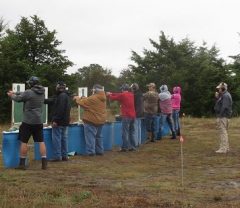All types of ammunition share certain properties which can be important to the user, and these are described below.
Primer Type:
While there are several distinctions that can be made here, most of them are only important to reloaders. For others, the only ones that matter are rimfire vs. centerfire, which describes in which part of the cartridge base is the primer installed. All normal self-defense calibers (pistol and rifle) are centerfire. Only .22 and smaller are rimfire. Do not dry-fire any rimfire firearm, unless the manufacturer says it is alright to do so. Very few do.
Loading:
This refers to the amount of gunpowder in the cartridge, which varies by caliber. A standard loading has no designation. If marked +P, the cartridge is overloaded to the first level, which is a somewhat “hotter” firing cartridge. If marked +P+, that has even more gunpowder, and is hotter still. Most modern firearms can handle +P without damaging the gun, but they should only be used in defensive ammo, not practice ammo. The .380 ACP is not rated for +P. Check your owner’s manual for advisability of using +P.
Bullet Type:
The choice is between expanding bullets (hollow-point, or HP), or non-expanding bullets, variously referred to as full metal jacket (FMJ), total metal jacket (TMJ), wad-cutters, round nose, flat nose, and other marketing terms. Hollow-points will expand dramatically during flight, or when hitting a solid surface, and the others will not. Hollow-points will minimize the possibility of over-penetration and danger to the public, and create a bigger wound channel, which maximizes stopping power. Hollow-points should always be used for self-defense purposes.
Bullet Weight:
This refers to the weight of the bullet, not the cartridge, and is expressed in grains. One grain is 1/7000 lb. A heavier bullet will hit the subject harder (more energy transfer), but will also generate slightly more recoil. For smaller calibers, that difference is negligible, but for .40, .45, or most revolvers, that could be a consideration, in terms of handling that gun. If accuracy inside 10 yards is not an issue, a heavier bullet maximizes stopping power (except for .40 S&W). Typical bullet weights are shown below:
.22 rimfire 40 gr
.380 ACP 85, 90, 95, 100
9mm Luger 115, 147
.40 S&W 165, 180
.45 ACP 185, 200, 220, 230
.38 Special 125, 158
.357 Magnum 125, 158
